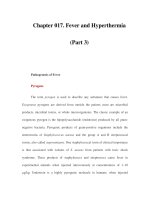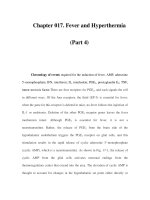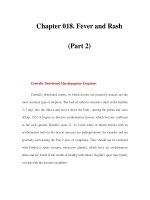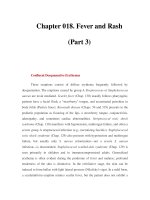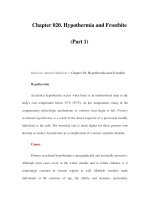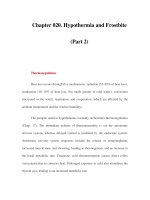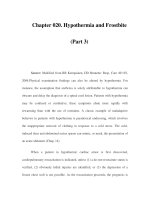Chapter 020. Hypothermia and Frostbite (Part 2) pot
Bạn đang xem bản rút gọn của tài liệu. Xem và tải ngay bản đầy đủ của tài liệu tại đây (14.03 KB, 6 trang )
Chapter 020. Hypothermia and Frostbite
(Part 2)
Thermoregulation
Heat loss occurs through five mechanisms: radiation (55–65% of heat loss),
conduction (10–15% of heat loss, but much greater in cold water), convection
(increased in the wind), respiration, and evaporation (which are affected by the
ambient temperature and the relative humidity).
The preoptic anterior hypothalamus normally orchestrates thermoregulation
(Chap. 17). The immediate defense of thermoneutrality is via the autonomic
nervous system, whereas delayed control is mediated by the endocrine system.
Autonomic nervous system responses include the release of norepinephrine,
increased muscle tone, and shivering, leading to thermogenesis and an increase in
the basal metabolic rate. Cutaneous cold thermoreception causes direct reflex
vasoconstriction to conserve heat. Prolonged exposure to cold also stimulates the
thyroid axis, leading to an increased metabolic rate.
Clinical Presentation
In most cases of hypothermia, the history of exposure to environmental
factors, such as prolonged exposure to the outdoors without adequate clothing,
makes the diagnosis straightforward. In urban settings, however, the presentation
is often more subtle and other disease processes, toxin exposures, or psychiatric
diagnoses should be considered.
After initial stimulation by hypothermia, there is progressive depression of
all organ systems. The timing of the appearance of these clinical manifestations
varies widely (Table 20-2). Without knowing the core temperature, it can be
difficult to interpret other vital signs. For example, a tachycardia disproportionate
to the core temperature suggests secondary hypothermia resulting from
hypoglycemia, hypovolemia, or a toxin overdose. Because carbon dioxide
production declines progressively, the respiratory rate should be low; persistent
hyperventilation suggests a central nervous system (CNS) lesion or one of the
organic acidoses. A markedly depressed level of consciousness in a patient with
mild hypothermia should raise suspicion of an overdose or CNS dysfunction due
to infection or trauma.
Table 20-2 Physiologic Changes Associated with Accidental
Hypothermia
S
everity
B
ody
Tempe
rature
C
entral
Nervou
s
System
Car
diovascula
r
Resp
iratory
R
enal
and
Endocr
ine
Neur
omuscular
M
ild
3
5°C
(95°F)–
32.2°C
(90°F)
L
inear
depressi
on of
cerebral
metabol
ism;
amnesia
;
apathy;
dysarthr
ia;
impaire
d
judgme
Tach
ycardia,
then
progressive
bradycardia
; cardiac-
cycle
prolongatio
n;
vasoconstri
ction;
increase in
cardiac
output and
blood
Tach
ypnea, then
progressive
decrease in
respiratory
minute
volume;
declining
oxygen
consumptio
n;
bronchorrhe
a;
bronchospa
D
iuresis;
increase
in
catechol
amines,
adrenal
steroids,
triiodot
hyronin
e and
thyroxin
e;
increase
in
Incre
ased
preshiverin
g muscle
tone, then
fatiguing
nt;
malada
ptive
behavio
r
pressure sm metabol
ism
with
shiverin
g
M
oderate
<
32.2°C
(90°F)–
28°C
(82.4°F
)
E
EG
abnorm
alities;
progres
sive
depressi
on of
level of
conscio
usness;
pupillar
y
dilatatio
n;
Prog
ressive
decrease in
pulse and
cardiac
output;
increased
atrial and
ventricular
arrhythmias
; suggestive
(J- wave)
ECG
changes
Hypo
ventilation;
50%
decrease in
carbon
dioxide
production
per 8°C
drop in
temperature
; absence of
protective
airway
reflexes
5
0%
increase
in renal
blood
flow;
renal
autoreg
ulation
intact;
impaire
d
insulin
action
Hyp
oreflexia;
diminishing
shivering-
induced
thermogene
sis; rigidity
paradox
ical
undress
ing;
hallucin
ations
S
evere
<
28°C
(82.4°F
)
L
oss of
cerebro
vascula
r
autoreg
ulation;
decline
in
cerebral
blood
flow;
coma;
loss of
Prog
ressive
decrease in
blood
pressure,
heart rate,
and cardiac
output; re-
entrant
dysrhythmi
as;
maximum
risk of
ventricular
Pulm
onic
congestion
and edema;
75%
decrease in
oxygen
consumptio
n; apnea
D
ecrease
in renal
blood
flow
parallels
decreas
e in
cardiac
output;
extreme
oliguria;
poikilot
hermia;
No
motion;
decreased
nerve-
conduction
velocity;
peripheral
areflexia;
no corneal
or
oculocephal
ic reflexes
ocular
reflexes
;
progres
sive
decreas
e in
EEG
fibrillation;
asystole
80%
decreas
e in
basal
metabol
ism



